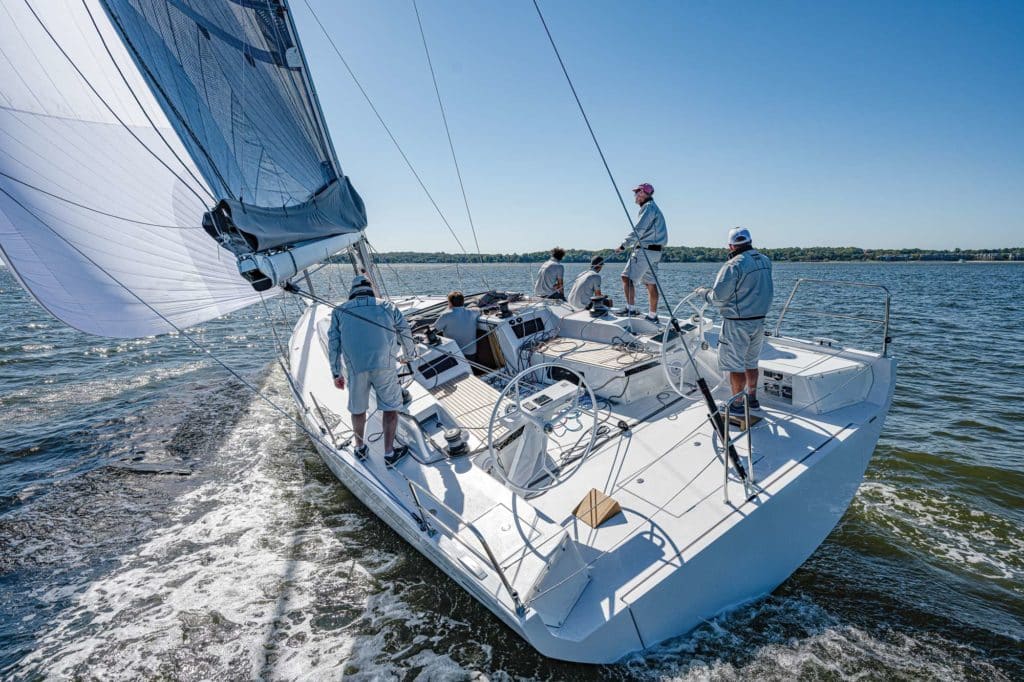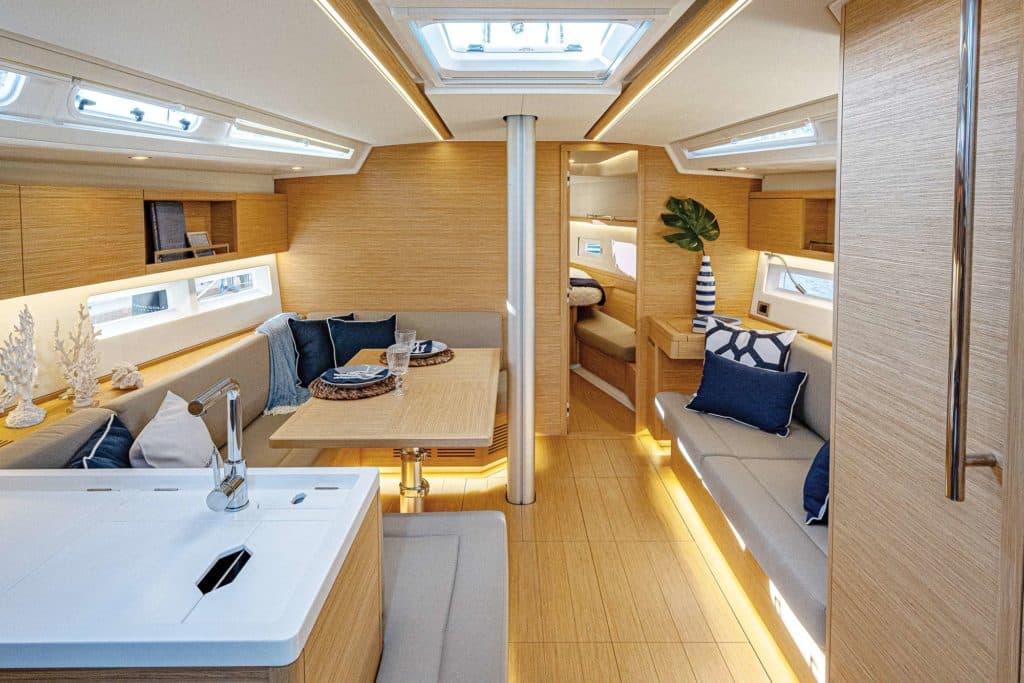Sailing World Magazine’s annual Boat of the Year tests are conducted in Annapolis, Maryland, following the US Sailboat Show. With independent judges exhaustively inspecting the boats on land and putting them through their paces on the water, this year’s fleet of new performance-sailing boats spanned from small dinghies to high-tech bluewater catamarans. Here’s the best of the best from our 2022 Boat of the Year nominees »
So, you’re in search of a sharp-looking yacht you can do the big annual race with and then comfortably take the spouse and family over the horizon for a getaway? Yes, you are, and there are plenty of boats new and old that check both boxes just fine, but how many of those quasi-cruisers would you seriously show up in at a big-boat world championship and confidently go to battle? Not many. With the Grand Soleil 44, however, you can, and you will.
Grand Soleil’s current chief designer, Matteo Polli, of Italy, earned a reputation early on in his career as one of the best young rule optimizers in the business, taking good designs and making them better. He’s been retained by both Italia Yachts and Grand Soleil, a reputable brand whose boats are built by Cantiere del Pardo, which has been building custom and production boats in Italy for nearly a half-century. Under Italia and Grand Soleil, Polli’s designs have bagged titles at successive ORC world championships, with the GS44 winning its division handily in 2021—albeit with a top-shelf pro crew and a grand-prix-caliber program. Still, with the GS44, Polli and the team of engineers and designers at Grand Soleil now command Europe’s coveted high-performance-crossover niche with a yacht that meets all of ORC’s cruiser and racer requirements (head, galley, storage, settee table, etc.) with a high-functioning race boat that’s also competitively priced.
The GS44 is available with either a racing or cruising deck layout; the boat our judges tested in Annapolis featured the racing deck, with six winches and a split German-style mainsheet system. As with most boats these days, an owner can choose from different keel options; this particular test boat came with the 7-foot-9-inch ORC-optimized keel. There are different sprit choices as well; the tested boat had the 2-meter carbon sprit, which is glassed to the hull. Interior component upgrades include foam-cored furniture and carbon tables.
The hull is vacuum-infused up to the waterline with vinylester and foam core, and a structural glass grid is laminated to the hull (not glued) with carbon reinforcement. While there’s nothing revolutionary with this approach, having the engine, keel and mast all tied into the grid makes for a noticeably stiff boat behind bright and light cabinetry. With its open and airy interior layout, the judges noted plenty of headroom, handholds, and space to manage and organize sails.

“The build is exceptional,” Greg Stewart says. “It’s all very clean, a high-quality and simple interior. Even under the floorboards and in the engine space everything was very tidy.”
With 14 feet of max beam, there’s plenty of volume inside the boat. You step down the wide and end-beveled companionway steps to an L-shaped galley to port and a giant shower and head to starboard. A big C-shaped settee and drop-down table are to port, opposite a long settee with a small nav station against the forward bulkhead. Forward of the mast is a large and open V-berth and head that take up nearly one‑third of the boat. All doors are solid wood with magnetic latches.
A race crew won’t be spending much time below, but on deck, where the action is, everything is where it’s supposed to be to get the boat around the course or down the track efficiently. “Of all the big boats we sailed, this is my favorite,” Chuck Allen says. “It has a racing feel and is really fun to drive—upwind and downwind.”
Fellow judge Dave Powlison agrees, noting that all the sail controls are set up correctly and easy to use.

“A lot of the boats in this performance-cruiser category tend to lead everything to the helmsman, which leaves it all jammed up in the back of the boat,” Stewart says. “This is a more normal race-boat layout, with a racing pit, the winches and the jammers all in the right places—everything works smoothly. I also like the wheel setup. It has a nice feel side to side, and having the mainsheet system immediately forward of the wheel is good. We had a great breeze for the boat, and that made it exciting. Upwind, it locked in right away and felt solid.”
The physical demand on the judges and short pickup crew for the test sail in 15 knots was eased by a small self-tacking jib that led to the cabin-top winches.
“The boat was underpowered with the little jib, which would be fine for cruising and taking it easy,” Allen says. “But it’s got a big main, and that was easy to control. It would have been much better with a proper headsail, but when we put the kite up—a beautiful A2—the boat really took off downwind.”
Inside jibes, he adds, are easy, with the clew able to get around the headstay without any problems. “It’s a good-size sprit,” he says, “so there’s plenty of room there to get the kite around quickly.”
The boat’s limit of positive stability (124) was calculated with 14 crew, but it is regularly raced with nine or 10 crew, according to the manufacturer. “I’d say this is a boat where you’d want to have 10 or 12 people,” Stewart says. “If it’s really windy, you’ll definitely want to stack the rail. It’s got a good stability number for this type of boat, though. The [stability] limit for offshore races is 115, so this could easily do any of the big long-distance races: the Bermuda Race, the Fastnet and the Transpac.”
With an ORC general purpose handicap of 555 seconds per mile, Stewart adds, the GS44 is a solid choice for a midsize boat.
“It’s a wide and powerful hull shape, but they softened out the corners, so it’s a cleaner wake in a lot of corners,” he says. “People are figuring out the chine is really only good for reaching, and a lot of the time you’re dragging that corner of the boat too much. But with this boat, when you lean it over, it gets longer quick.”
The boat was tested with an asymmetric spinnaker, but it would be easy to add a standard pole and symmetric setup for ORC racing, Stewart adds. “If you’re doing the windward and leeward regattas, like the ORC Worlds where there are five or six buoy races and two distance races, you’re going to want to go with the pole and masthead kites—just round the weather mark, square back, and go straight downwind at 170 true [wind angle].”
Throughout the week of sea trials in Annapolis, the judges sailed a wide variety of crossover designs, many leaning more heavily to the cruising set, so it’s hardly surprising the GS44 won unanimous favor when it came time to narrow down their top choice.
“We all thought it’s a great sailing boat, and it was presented well by the Grand Soleil guys,” Allen says. “This is set up as a race boat. For example, there was no cockpit table to get in the way like there was on all the other boats we sailed. Yes, it’s a racer-cruiser or high-performance cruiser—whatever they want to call it—but we all like it because we could easily see its racing potential.”









